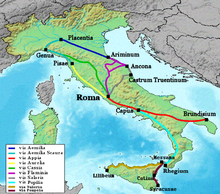Via Emilia
The Via Emilia ( Latin Via Aemilia , German Aemilianische or Ämilianische Straße ) is a former Roman road in northern Italy , which led along the northern edge of the Apennines from Placentia ( Piacenza ) to Ariminum ( Rimini ). It is named after the Roman patrician family of the Aemilians . The historical region of Emilia (now Emilia-Romagna ) was named after the road over time.
Today, Via Emilia is part of the Italian highway network as Strada Statale 9 Via Emilia .
Origin and course
The Via Emilia was built by order of the Roman consul Marcus Aemilius Lepidus in 187 BC. Created. It was the continuation of the Via Flaminia , which led from Rome to Rimini and connected the cities of Rimini (Ariminum), Imola , Bologna (Bononia), Modena (Mutina), Reggio Emilia (Regium), Parma and Fidenza (Fidentia) to Piacenza (Placentia). This was later followed by the Via Aemilia Scauri to Genoa and Pisa and the Via Postumia to Aquileia .
Remains and sites
Milestone 78 from Rimini was found in the river bed of the Reno in Bologna. It bears witness to the restoration of the road from Rimini to the Trebbia river by Emperor Augustus in 2 BC. Chr.
Remains of a bridge over the Reno were discovered in the 1890s , consisting of parts of the parapet on both sides, which were originally about 11.6 m apart and were made of brick-faced concrete. They were part of a restoration as the earlier construction (probably in Augustus' reconstruction) was made of red Veronese marble . A massive protective wall, which was slightly above, must come from Christian times, as a large number of Roman gravestones were used for its construction. When the bridge collapsed (around the year 1000 ) , the river bed was filled by about 6 meters.
Ruins of other ancient bridges are also still there. In San Savignano sul Rubicone in the Forlì-Cesena province , the Roman bridge was only blown up during World War II . Today's bridge is a reconstruction. The river it spans could be the ancient Rubicon .
literature
- Michael Rathmann : Via Aemilia. In: The New Pauly (DNP). Volume 12/1, Metzler, Stuttgart 2002, ISBN 3-476-01482-7 , column 158 f.
- N. Cantarelli et al. (Ed.): Evoluzione di un territorio. Aemilia, una via, una regione. Parma 1989.
